It seems we can’t find what you’re looking for. Perhaps searching can help.
Sign Up for newsletter!
Subscribe to get the latest eBook!
Hotline






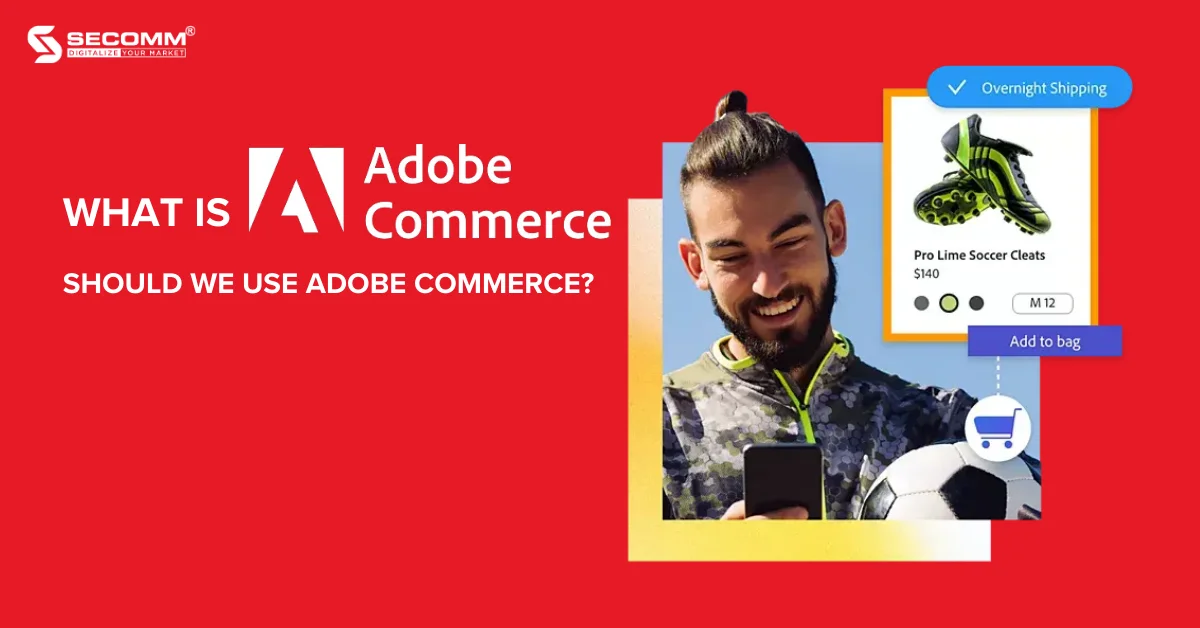
According to Adobe’s report in January 2023, there are more than 100,000 websites built using Adobe Commerce. Among them, over 50,000 websites are actively running, and more than 50,000 websites are in the deployment phase. This is an extremely impressive number for a platform specialized in supporting large enterprises like Adobe Commerce.
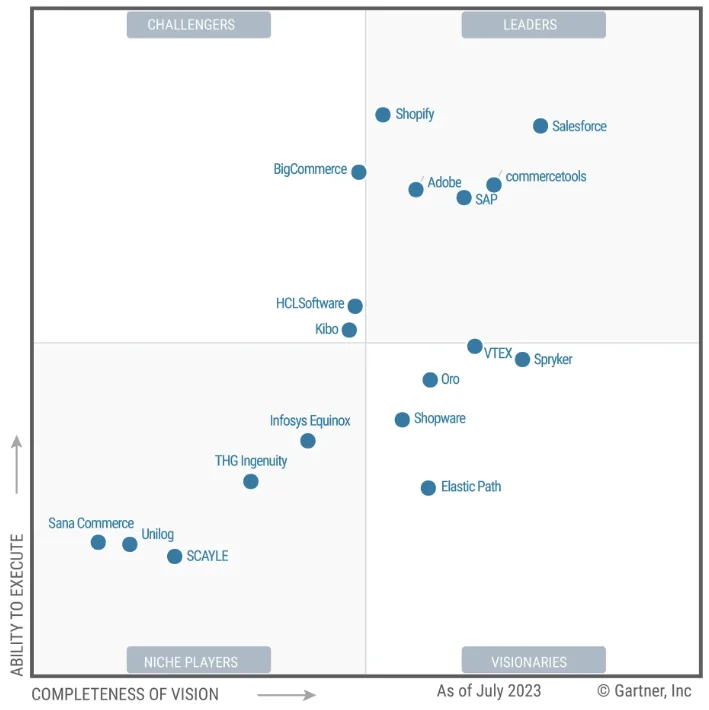
In 2023, Adobe Commerce was recognized by Gartner for its outstanding achievement, ranking first in the list of leading platforms in digital commerce for seven consecutive years.
Adobe Commerce is an open-source eCommerce platform designed specifically for businesses ranging from medium to very large scale, offering high customization and scalability.
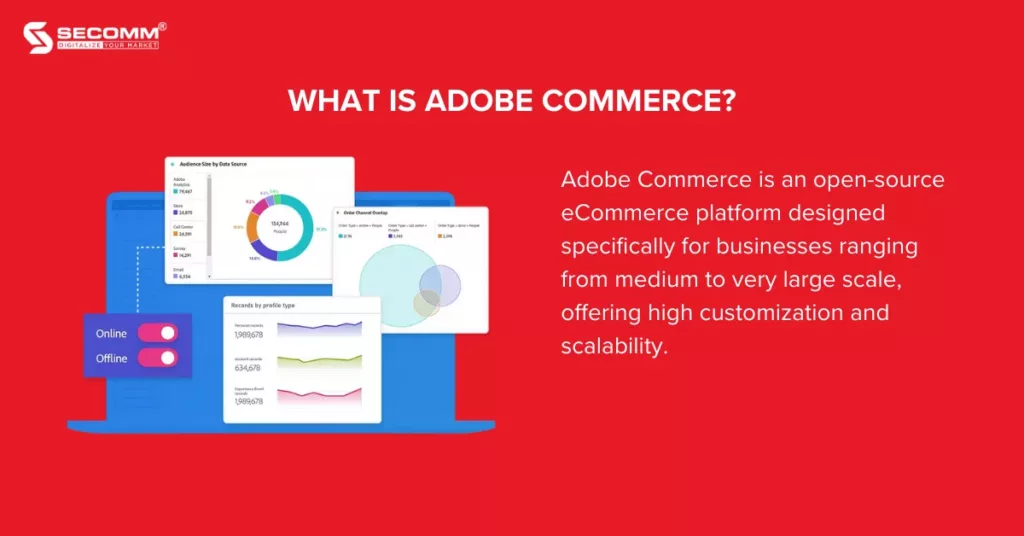
Formerly known as Magento Commerce, it was founded in 2007 by Roy Rubin and Yoav Kutner in Culver City, California, USA. After several changes of ownership, in 2018, Adobe acquired Magento for $1.68 billion and rebranded it as Adobe Commerce. Currently, Adobe Commerce is part of the Adobe Experience Cloud, a product and service suite helping businesses create, manage, and distribute digital experiences.
Adobe Commerce has two main versions: Adobe Commerce Cloud and Magento Open Source.
Adobe Commerce Cloud is a paid version, deployed and managed on the cloud by Adobe. It is divided into two types: on-premise, allowing businesses to be self-sufficient in hosting, and on-cloud, providing hosting at a specific cost.

Magento Open Source is a free version that can be downloaded and used by anyone. It provides essential functionalities for creating and managing online stores.
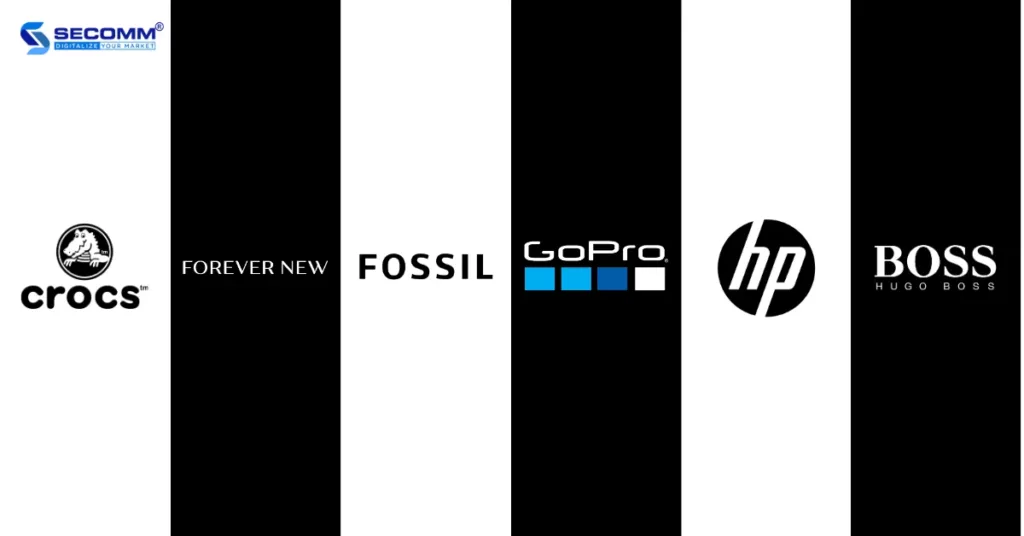
In addition, Adobe offers several additional versions of Adobe Commerce:
The cost of using Adobe Commerce depends on the version being used.
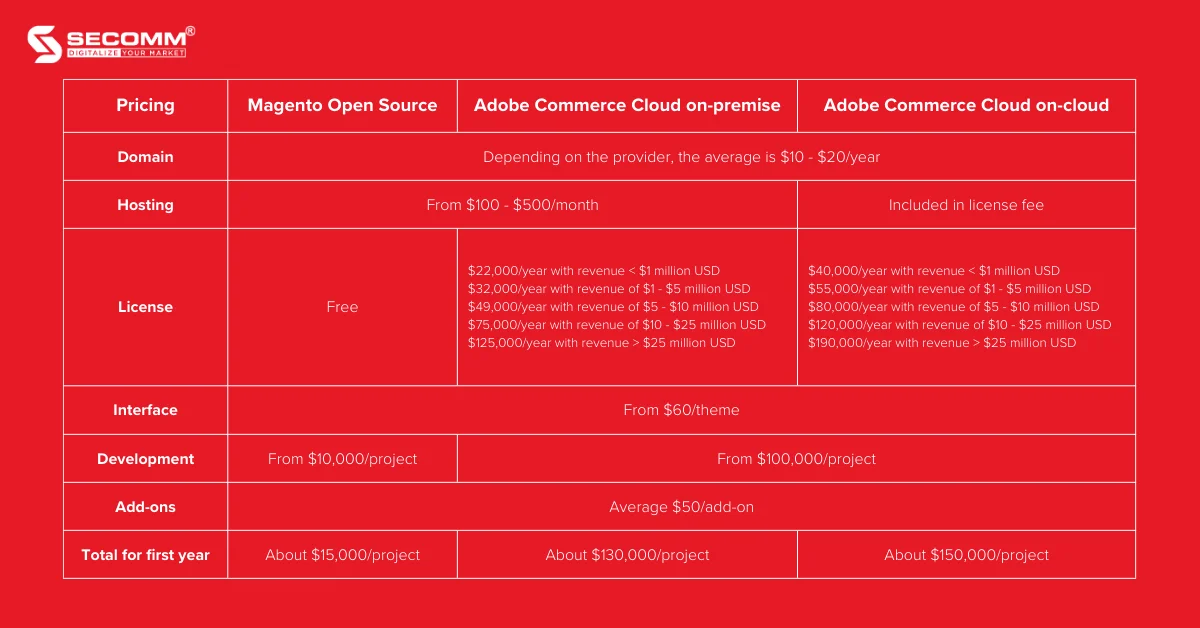
For Adobe Commerce Cloud (On-Cloud): Adobe provides hosting and operates Adobe Commerce on its cloud. License costs for Adobe Commerce on-cloud range from $40,000 to $190,000 per year, depending on the system’s complexity, scale, and business requirements.
For Adobe Commerce Cloud (On-Premise): Businesses need to purchase licenses and install the software on their servers. License costs for Adobe Commerce on-premise range from $22,000 to $125,000 per year, depending on system complexity, scale, and business needs.
For Magento Open Source: Magento provides a free license, and the overall cost is generally more reasonable compared to the two solutions above. However, the available built-in functionalities are limited, and additional investments are required for feature development and integration with third-party services.
In addition to license costs, businesses also need to invest in interface design, development costs, extension utility costs, and employee salaries.
Note: The cost of using Adobe Commerce can be significantly influenced by factors such as business scale, feature requirements, integration needs, and customization requirements.
Read more: Shopify Plus vs Adobe Commerce: Key differences 2023
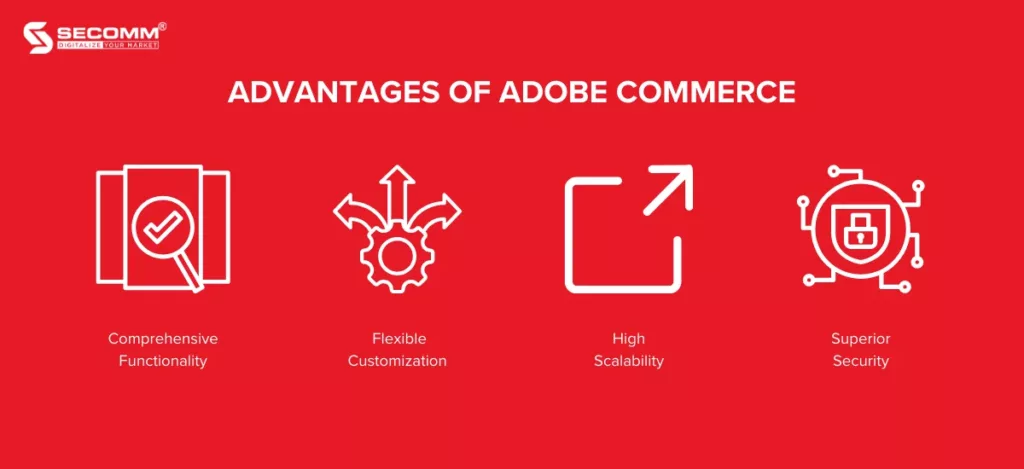
Adobe Commerce is a powerful eCommerce platform, providing all the essential features for building and managing a comprehensive eCommerce website. From product portfolio management, content creation, and conducting transactions, to marketing campaigns and customer management, Adobe Commerce is equipped with all the necessary tools.
In addition to basic features, Adobe Commerce offers many extensions with advanced functionalities.
One of the significant strengths of Adobe Commerce is its globally experienced support community, consisting of professional developers who assist in finding and solving any technical challenges or customizations needed for businesses. This creates favourable conditions to meet every requirement and goal of the business’s eCommerce.
Adobe Commerce possesses all the advantages of an open-source platform with flexible customization capabilities. Especially with ownership and control over the entire source code, businesses can easily customize code sections within the system, easily update, or even develop new features based on specific business needs.
In addition to customization capabilities, Adobe Commerce has excellent scalability for websites. Adobe Commerce allows businesses to expand from one website to multiple websites, one store to multiple stores while still managing everything on the same system. Additionally, Adobe Commerce supports multilingual and multi-currency conversions, helping businesses expand globally.
High-security capability is also a standout advantage of Adobe Commerce with regular system monitoring, proposed security solutions, enhanced security for administrators, and the ability to prevent bots or unauthorized malicious code. This platform helps businesses minimize potential risks from data systems and transaction processes on the system
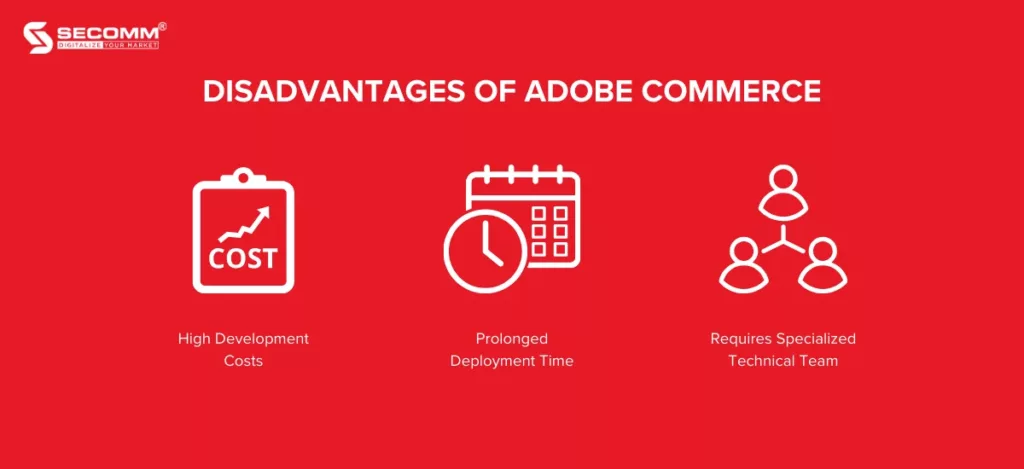
Due to its numerous outstanding features in functionality, customization capabilities, scalability, and high security, the cost of owning an Adobe Commerce website is inevitably high. As estimated earlier, websites developed on the Adobe Commerce platform often have higher costs compared to other platforms, ranging from $10,000 to $300,000 depending on the system’s complexity.
A complete Adobe Commerce project requires a deployment time ranging from 3 months to 1 year. This extended duration slows down the digital transformation process of businesses, making it challenging for them to keep up with the pace of development among competitors and stay updated with market trends.
To build and operate an in-depth eCommerce website system tailored to the specific characteristics of each product and industry with high performance, businesses require a specialized technical team with in-depth expertise. This is particularly crucial for complex Adobe Commerce projects, demanding a high level of technical specialization and experience on the Adobe Commerce platform.
As one of the world’s most renowned sportswear brands, Nike aimed to adopt a personalized eCommerce approach with a focus on mobile device experience. Hence, Nike chose Adobe Commerce to enhance its functionality, concentrating on user experience, increasing interaction, and optimizing images and CTA buttons for smaller screens.

Additionally, customizing and optimizing the eCommerce website-building method through the Headless Commerce API architecture contributed to Nike’s success, turning the brand into a market leader and gaining more market share than its competing counterparts.
Canon, a multinational corporation based in Japan specializing in manufacturing cameras, printers, optical equipment, digital imaging devices, and office equipment, needed to build an eCommerce website to meet digital transformation needs after a long period of traditional business. Canon decided to select Adobe Commerce to deploy a comprehensive eCommerce solution.

“The Commerce and Experience Manager tech stack helps us compress projects that previously took months of development time into just weeks. We can do so much more than before — if we’re developing a new component and trying to get it out within a couple of weeks, we can do that now” — Michael Lebron, Senior Director and Head of Front Office Applications
Annam Gourmet is a premium food and beverage retail brand in Vietnam established in 2001 by a French-Vietnamese couple. Although Annam Gourmet had an online presence before, it was mainly used to develop the brand, and the effectiveness of eCommerce was not emphasized. Annam Group, the parent company of Annam Gourmet, along with partner SECOMM, chose to use Magento 2 to build an eCommerce website.
Currently, Annam Gourmet’s Magento 2 website has officially launched, operating stably and effectively, helping the business successfully transform in the eCommerce market. Besides the Annam Gourmet project, Magento is also chosen by the Annam Group for other retail eCommerce systems within the group, such as The Warehouse (wine retail) and Nespresso.

In general, Adobe Commerce is a suitable eCommerce platform for businesses of all sizes, from startups and SMEs to large corporations. However, issues related to budget, time, and specialized teams have made many small and medium-sized enterprises hesitate to use Adobe Commerce for deploying eCommerce websites. Therefore, Adobe Commerce is often invested in by large enterprises to build in-depth eCommerce systems.
With profound experience and the development of numerous complex eCommerce systems on Adobe Commerce, such as Laybyland (Australia, the US, New Zealand), Jasnor (Australia, New Zealand), and The Warehouse (Vietnam), SECOMM understands the challenges in the platform selection and eCommerce deployment that businesses are facing.
Contact SECOMM today or call directly at the hotline (028 7108 9908) for a free consultation on deploying Adobe Commerce for your brand.
 2
2
 8,912
8,912
 0
0
 2
2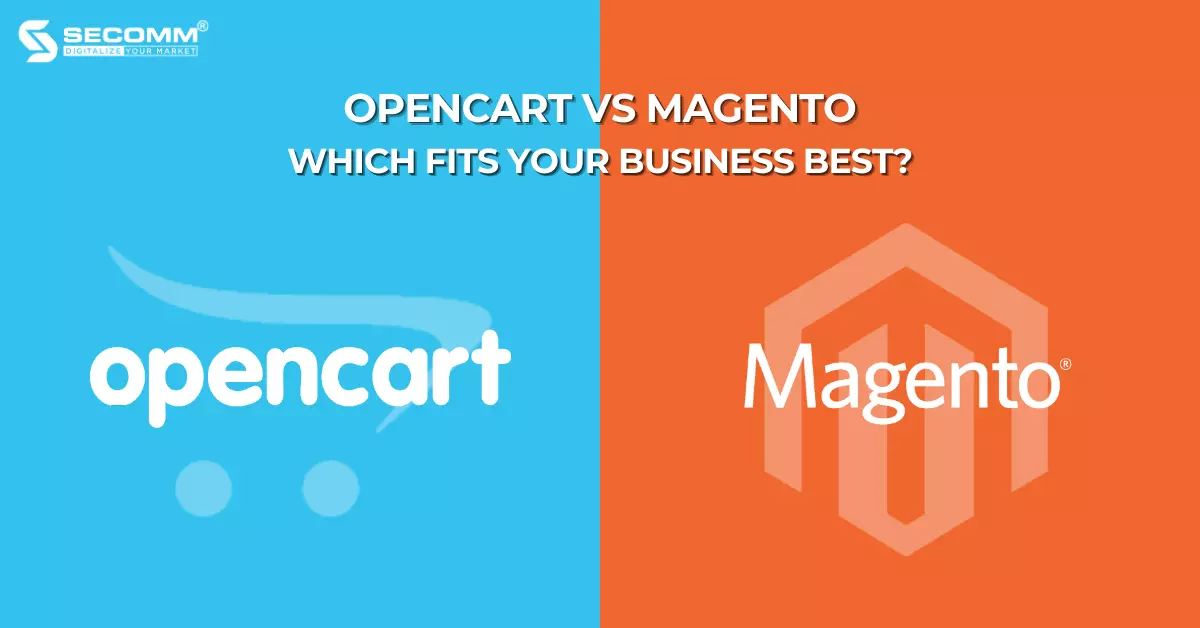
OpenCart and Magento have consistently been pitted against each other as open-source platforms for businesses in need of building specialized eCommerce websites, particularly for enterprises and corporations.
So, which of these open-source eCommerce platforms, OpenCart or Magento, is the right fit for your business?
OpenCart is a freely developed open-source eCommerce platform designed in PHP. It’s favored for its user-friendliness and simplicity, boasting an easy-to-navigate admin dashboard that allows product management, promotions, order processing, and reporting without requiring technical expertise.
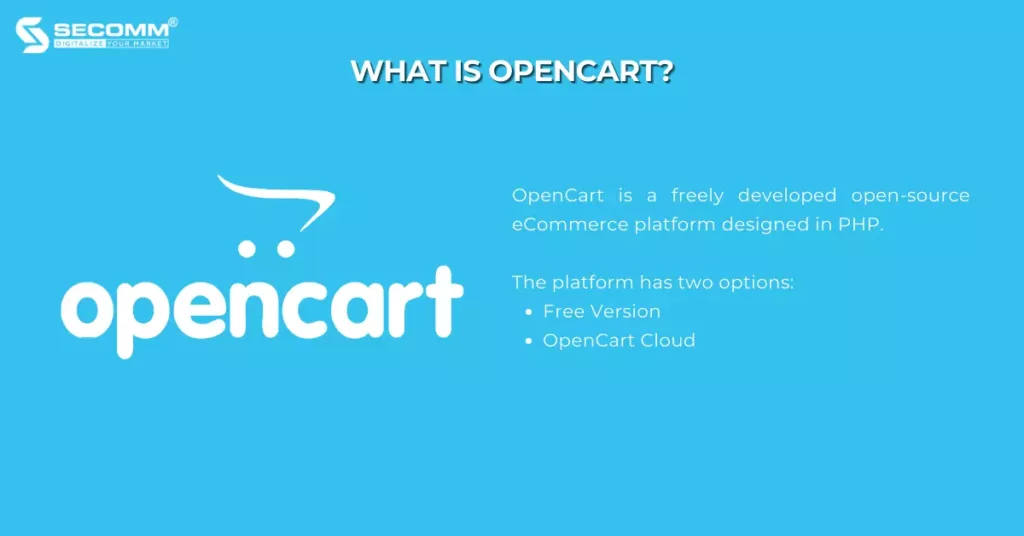
OpenCart offers two options for businesses:
As per Build With data, OpenCart has been adopted by over 400,000 websites, primarily by small to medium-sized businesses in the United States, Russia, the United Kingdom, Ukraine, and Brazil.
Related Reading: What is OpenCart? Key Pros and Cons of OpenCart
Magento (Adobe Commerce), much like OpenCart, is an open-source eCommerce platform developed using the PHP programming language. Magento stands as the ‘pinnacle’ among all open-source eCommerce platforms due to its comprehensive control and high scalability, offering a plethora of specialized features.
At present, Magento provides three primary editions, which are:
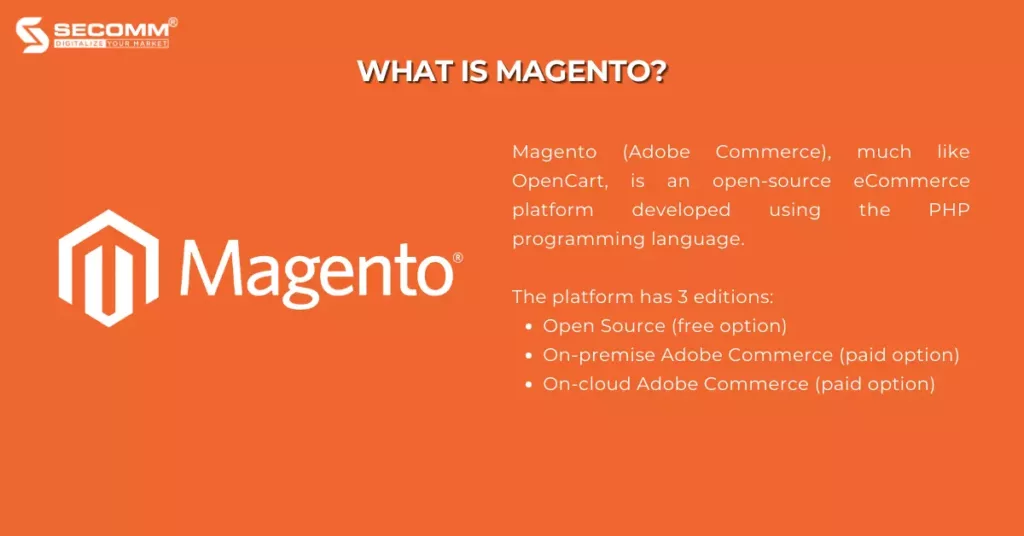
According to BuildWith, Magento supports over 160,000 websites, with significant popularity among large businesses in the United States, the United Kingdom, the Netherlands, and Germany.
Given the differences in service offerings between the paid versions of OpenCart and Magento, this SECOMM article will focus on comparing the two free versions.
Related Reading: What is Magento? Key Pros and Cons of Magento
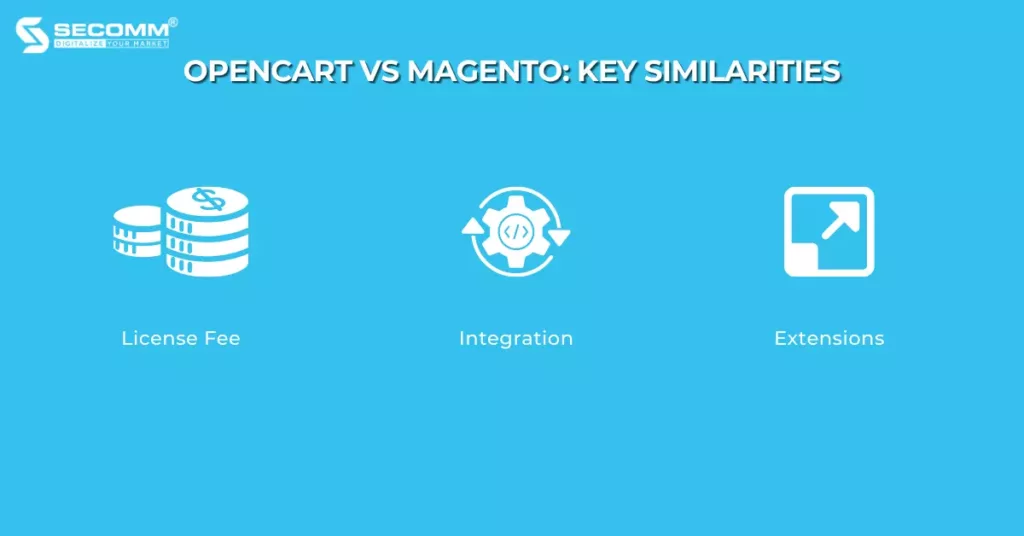
Overall, OpenCart and Magento are both open-source platforms developed using PHP. They are both robust eCommerce platforms with powerful features and a multitude of additional utilities.
The usage costs of OpenCart and Magento are quite alike, as both offer free enterprise versions that can be downloaded and installed without any charges.
Since they are open-source platforms, both possess exceptional customization capabilities for integrating third-party add-ons.
This enables businesses to effortlessly install and manage various management systems like POS, ERP, CRM, and others within a single system.
OpenCart offers an extensive library of extensions, with approximately 13,000 extensions at your disposal. Likewise, Magento boasts a vast collection of extensions, with over 5,000 to choose from.
Both platforms enable businesses to enhance their eCommerce websites with a plethora of additional features using these extensions, eliminating the need for coding concerns.
OpenCart is recognized as being more user-friendly for beginners, primarily due to its intuitive interface and straightforward installation process. However, businesses should still possess a basic level of technical knowledge related to hosting, FTP (File Transfer Protocol), security upgrades, and the like.
Within the admin dashboard, users can effortlessly navigate through sections such as ‘Catalog,’ “Extensions”, “Sales”, “System”, “Reports”, and “Help”.

Magento isn’t a “playground” suited for beginners due to its intricate installation process, which demands a high level of technical expertise to set up.
While Magento 2 is considered more user-friendly than Magento 1, the admin dashboard still offers a multitude of options that can pose challenges for newcomers, especially when it comes to understanding Magento-specific terminology, resulting in a time-consuming learning curve.
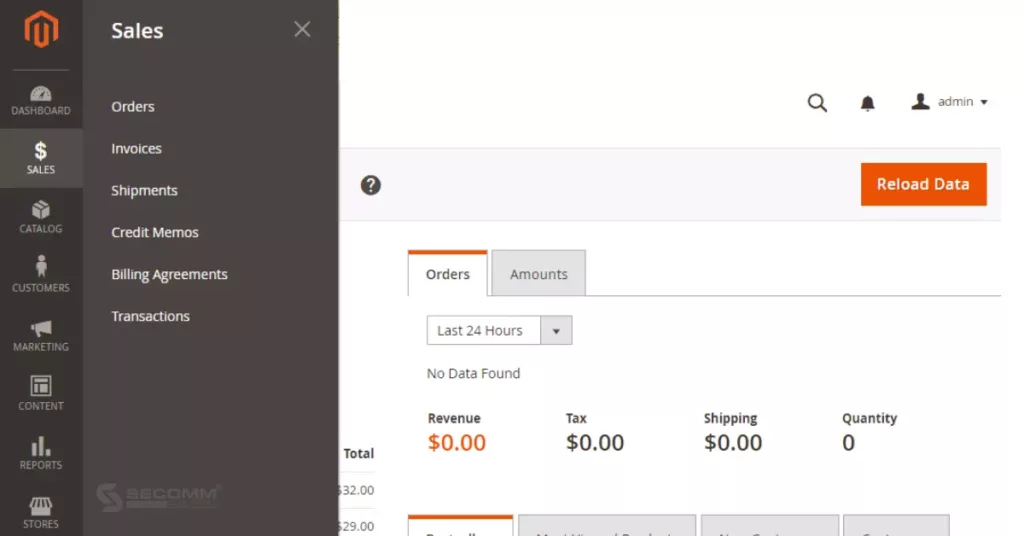
OpenCart provides around 500 themes, available in both free and paid options (ranging from $60 to $70), catering to diverse industries. This platform enables businesses to preview their website’s appearance with various themes before making a purchase. Subsequently, businesses can customize these themes according to their specific needs.
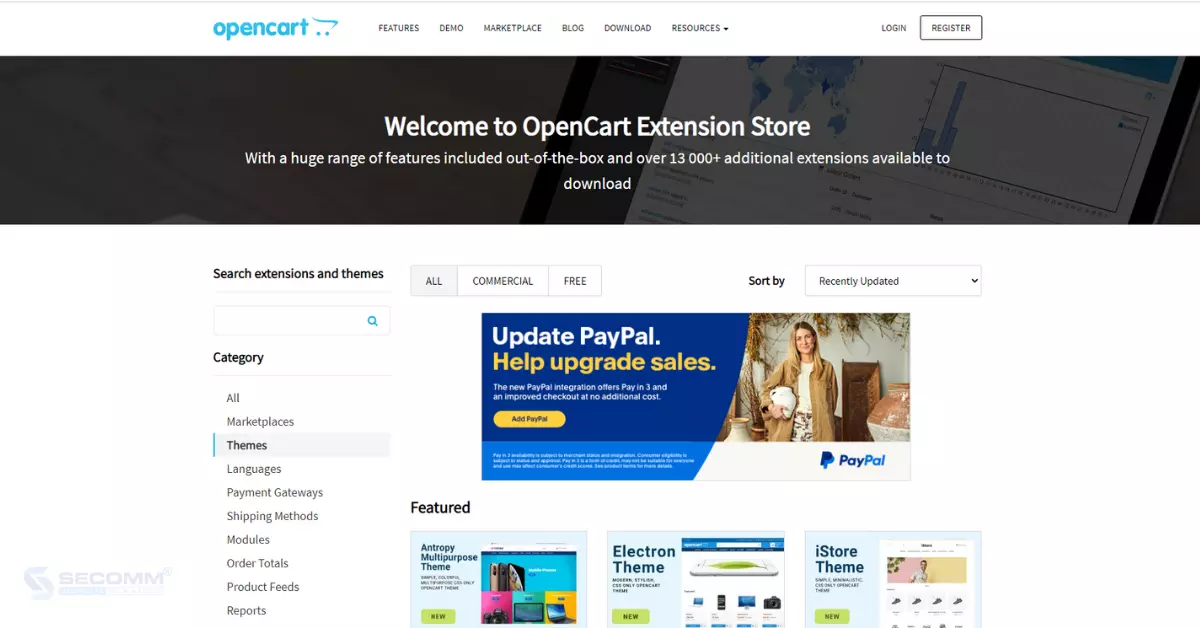
In the case of Magento, businesses have three options for creating user interfaces:
In summary, both OpenCart and Magento offer a wide selection of budget-friendly themes, but Magento allows for more extensive customization to optimize the eCommerce website’s interface.
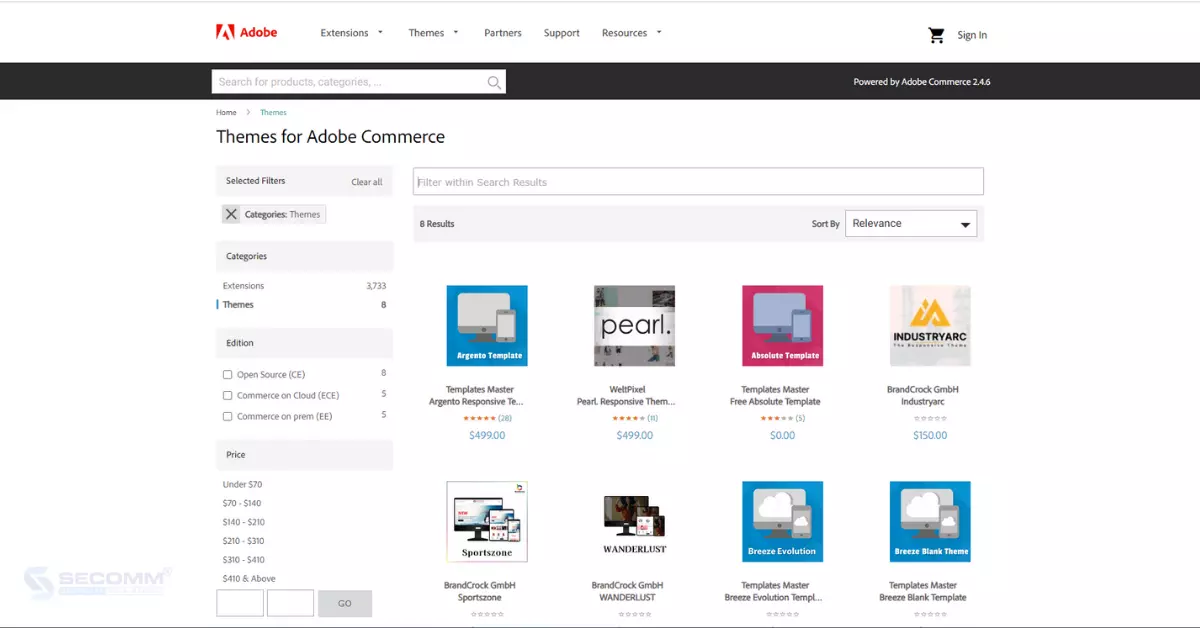
In terms of scalability, OpenCart is suitable for small and medium-sized business websites because it can only handle a limited number of products and transactions. On the other hand, Magento is specifically designed to manage large and complex eCommerce websites, capable of handling thousands of products and daily transactions without performance issues.
When it comes to flexibility, OpenCart provides a variety of extensions and add-ons to enhance website functionality. However, its flexibility may be somewhat constrained when dealing with intricate custom requirements. In contrast, Magento offers a higher degree of flexibility, enabling businesses to customize every aspect of their website. It boasts a comprehensive system of modules and better compatibility with third-party integrations, allowing businesses to tailor and expand their website to suit their specific needs.
Overall, Magento surpasses OpenCart in terms of scalability for eCommerce websites.
OpenCart offers two types of support to its users:
Magento provides a Help Center, but its support staff primarily focuses on Adobe Commerce, which may not fully address the needs of businesses using Open Source. However, Magento boasts a global developer community of over 13,000 individuals, making it relatively straightforward to find solutions.
OpenCart doesn’t assume responsibility for the security of eCommerce websites as it operates on an open-source platform. This means that OpenCart’s code and framework are publicly available, rendering websites more susceptible to potential attacks.
In contrast, despite also being an open-source platform, Magento places a strong emphasis on security. Magento has consistently released security patches since 2015 to identify vulnerabilities. This commitment ensures that eCommerce websites built on Magento maintain a high level of security, instilling confidence in online shoppers.
Through the use of third-party tools such as Mage Report and Mage Scan, businesses can assess their security status. Additionally, Magento employs CSP (Content Security Policy), which offers a structured set of principles for restricting browser content to trusted services only. This allows browsers to determine which web tools to block and which ones to trust.
Even though both OpenCart and Magento are provided with free licenses, there is a significant difference in the development costs for eCommerce websites.
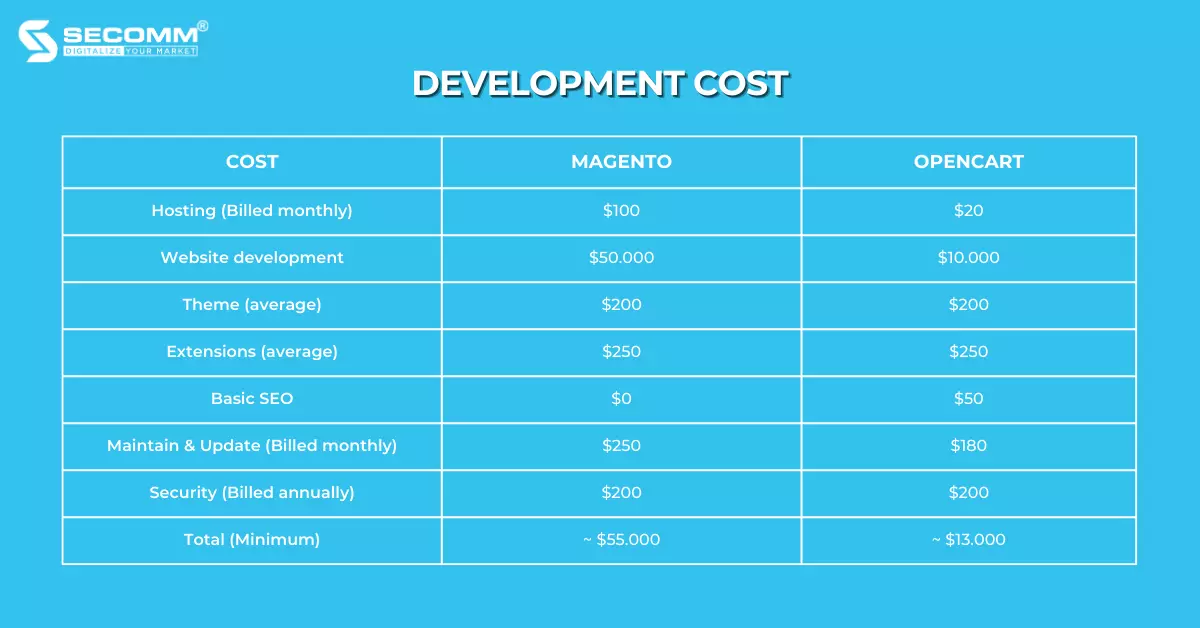
While Magento comes with a higher implementation cost than OpenCart, it offers a plethora of features for eCommerce websites. These include advanced search capabilities with Elasticsearch and OpenSearch, content editing tools that don’t require coding, support for categorizing a wider range of product types, and advanced shipping configuration, among others. In contrast, adding these features to OpenCart would necessitate the use of numerous extensions and increased storage resources to ensure efficient operation.
Considering the evaluations presented earlier, OpenCart proves to be a suitable choice for small and medium-sized enterprises (SMEs) seeking to establish their eCommerce websites. In contrast, Magento is an excellent fit for both SMEs and large corporations with specific and highly customizable eCommerce system requirements. Magento allows businesses to own a tailor-made system by either starting with a basic eCommerce website and gradually enhancing it or by creating a comprehensive system from the ground up.
With our extensive experience in implementing eCommerce solutions for clients across diverse countries, SECOMM comprehends the challenges and complexities that businesses encounter when selecting the ideal platform for constructing a professional eCommerce system.
Contact SECOMM today or call our Hotline at (02871089908) for a complimentary consultation.
 2
2
 9,143
9,143
 0
0
 1
1
It’s important when it comes to choosing the right platform to build an effective eCommerce system. Businesses have many options to choose from either the open-source eCommerce platforms or any eCommerce platform as a service (SaaS, Paas), depending on the eCommerce business model and business plans.
To have a comprehensive eCommerce system, the open-source eCommerce platform is the business’s best friend, because of the great flexibility, scalability, customization according to the products, and catalogue characteristics.
In addition, the open-source platform also allows businesses to own the entire system source code and data. With all of these outstanding features, open-source platforms are slowly becoming the eCommerce development choices that many businesses are aiming for.
However, businesses need to carefully consider choosing the right platform. There are a lot of open-source eCommerce platforms on the market (OpenCart, WooCommerce, Magento,…), and each platform has its pros and cons.
WooCommerce is a WordPress plug-in introduced in 2011, completely free, and allows businesses to turn their WordPress sites into online stores, with built-in and additional features.
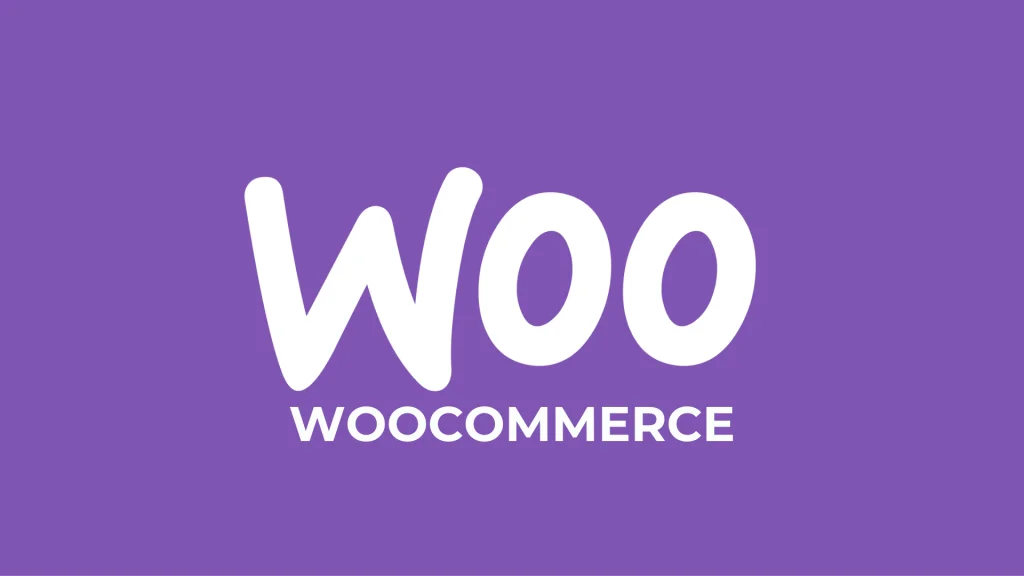
Ease of use
Many businesses that have been using WordPress for their online business, must be familiar with WooCommerce. Businesses can turn their website into an eCommerce system when implementing the WooCommerce Plugin into their WordPress website easily.
They can set up, integrate, and adjust functions on themes, and add-ons,… that have been built with high functionality from developers in a strong community around the world, making it easier to modify, and more flexible on the platform
In addition, WooCommerce is carefully built, convenient, also has huge and rich theme storage, and it is easy for businesses to design and build an e-commerce system right from the start, without knowing too much about technology.
Rich in features and add-ons
WooCommerce allows and supports features such as product management, orders, inventory, search engine optimization (SEO), discounts, sales, statistics reports, easy integration of payment units, shipping, handling units, and shopping experience optimization on all devices, making it easy for businesses to build a comprehensive system for simple and effective e-commerce business development.
Regarding security, WooCommerce ensures that businesses have the best security through a regularly updated system, and also ensures all of the business transactions are secure and safe through the features from the third-party services.
Low performance
One of the biggest disadvantages for businesses using the WooCommerce platform is the low performance, the system is easily overloaded with plug-ins and themes, and the number of products does not surpass 2000 SKUs, and often affects the system if the number of products exceeds the limit. Therefore, when businesses want to expand their business, it is necessary to consider switching to another platform.
Limited customization
WooCommerce is a plugin for WordPress, the platform lets businesses customize their eCommerce system, but building a complete, and comprehensive eCommerce system with unique features is very limited. The modification can cause instability for the system as well as the possibility that those built-in features are not compatible with the platform.
To customize a suitable system based on the available features system, businesses will face many challenges, it takes a lot of time and resources.
WooCommerce is perfect for businesses that are using WordPress and are looking to develop an e-commerce system. However, WooCommerce is not perfect for developing a comprehensive e-commerce system and expanding the business model. Some brands are using WooCommerce around the world such as Pluralsight LLC, and Gordon College, and famous brands in Vietnam such as Vietnam Airlines, Pharmacity, etc.
OpenCart is an open-source CMS (Content Management System) using PHP language, similar to WordPress but specially designed for e-commerce.
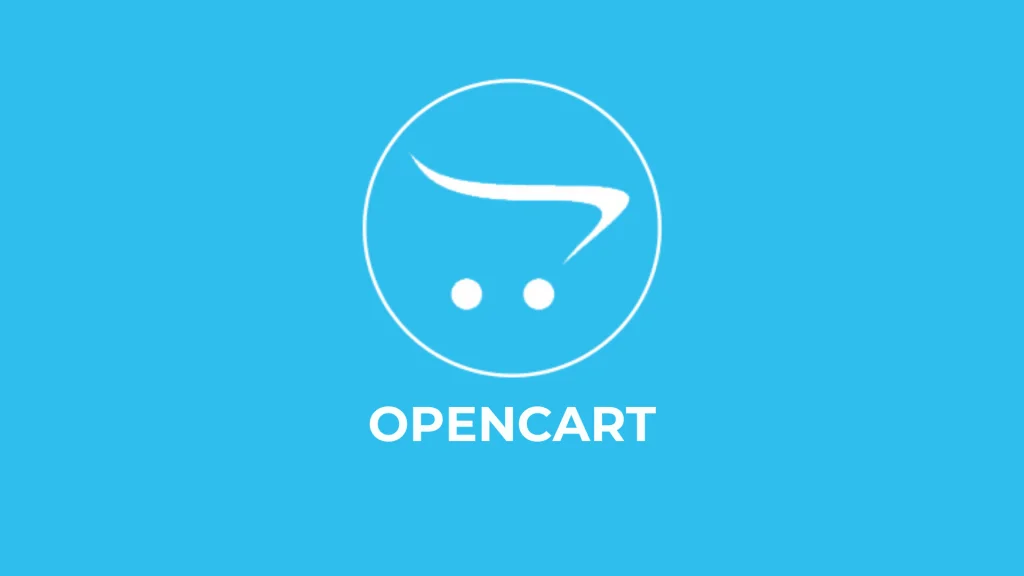
Friendly interface and easy-to-use
OpenCart provides an intuitive, easy-to-use, friendly interface, which is specialized for
the eCommerce industry. In addition, OpenCart also provides a completely free variety of interfaces and features, making it easy for businesses to develop e-commerce systems with basic website development knowledge and skills. Because OpenCart is built based on the MVC Model (Model- View- Controller), developing and writing a module for an e-commerce system on this platform is also quite easy.
Full of basic e-commerce features and a variety of add-ons.
OpenCart supports businesses with every basic e-commerce feature. Since OpenCart is a CMS specially designed for e-commerce, the open-source commerce platform such as OpenCart fully supports basic e-commerce functions such as sales, sales management, data management, statistics, customer data lists, and invoices.
Businesses can easily create and manage many different stores on the same system without having too much technical knowledge. This also means that businesses can access and manage all data of multiple stores at the same time with just one single central OpenCart system.
Not only supporting businesses build and manage an eCommerce system, but OpenCart also supports marketing such as search engine optimization (SEO), keyword advertising (Adwords), marketing programs, and affiliate marketing programs to be able to reach customers more easily, increase sales on the eCommerce system.
On top of the basic e-commerce functions, OpenCart also has additional applications to support businesses such as daily business operations and product categories. The backup and restore function helps businesses always have a backup system in hand and ready to restore all of the data on the system in case of an emergency
Besides that the platform also has many features such as a shopping cart, support customers to buy many products at once; gift features issuing gift cards, and loyalty programs. In addition, businesses can integrate other utilities such as payment gateway VNPay, and PayCEC, to help businesses have a better, faster, and seamless shopping experience.
Customization
With all of the basic features of an open-source program, businesses can easily modify, edit and customize on the OpenCart platform. In addition, the OpenCart e-commerce platform has a great ecosystem with many functions suitable for e-commerce business, firms can fully explore, as well as develop modules that are suitable for a satisfactory e-commerce system.
Although the OpenCart platform has many advantages that are the best fit for e-commerce businesses, there are also some limitations that businesses should be aware of when using the platform.
Low performance, and unstable
Although the platform is highly rated and well designed for the eCommerce industry, the system is still not stable enough because the modules and functions are not fully optimized, many errors occur while operating, as well as the installation steps are still very perplexing.
Therefore, businesses still encounter many problems when building and operating, which might affect the business’s processing speed as well as the revenue.
Feature development costs can become expensive
OpenCart owns extensive storage with quite a lot of basic features to serve e-commerce businesses quickly and conveniently, but the platform still cannot meet the advanced and specialized features according to specific product characteristics, product categories, and business needs of each field.
Therefore, businesses will need to invest time and resources to develop advanced features. For example, the SEO feature is supported on the platform, but there are many difficulties when censoring content via Google, not as effective as on the WordPress platform.
The OpenCart platform is relatively new compared to other platforms on the market, has many limitations and needs to be optimized. Similar to the WooCommerce platform, this is a good platform to start an ecommerce business, but not perfect for developing a comprehensive ecommerce system that goes along with growing and scaling your business. Some of the international brands that are using OpenCart such as Sunglass Hut, Virgin Enterprise, Audio-Technica Ltd, and the brands in Vietnam that are using OpenCart are Mobifone, RitaVo, etc.
Magento is an open-source platform specially built for e-commerce. It is recognized as one of the leading e-commerce platforms today, offering various outstanding advantages such as high flexibility, a diverse ecosystem, and optimal security. Currently, Magento has two versions: Magento Open Source (free) and Magento Commerce (paid).
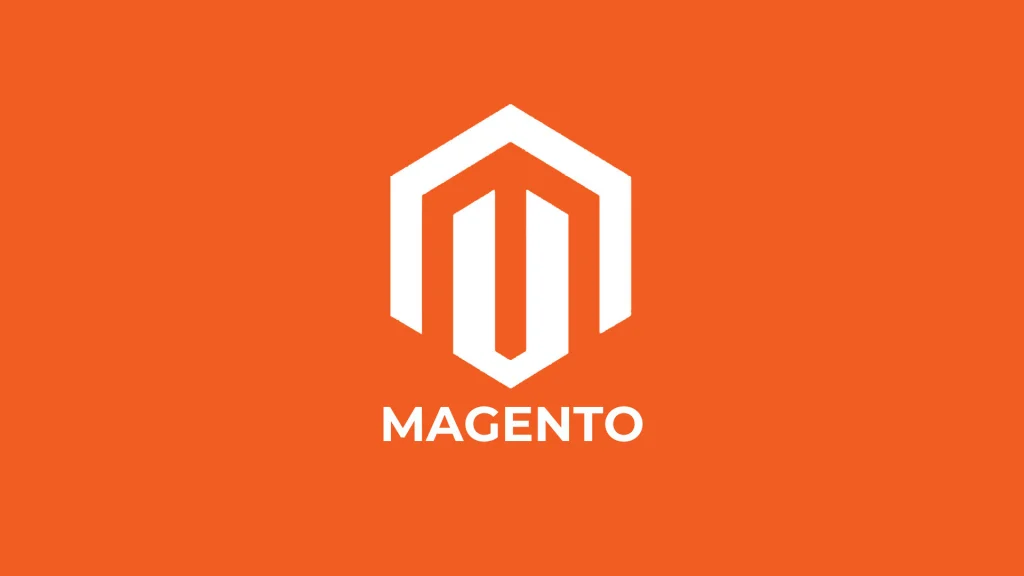
Diverse features for e-commerce from basic to advanced
Magento possesses many features available from basic to advanced to develop a complete e-commerce system including Category Management, Content Management, Customer Management, Marketing Management, Order Management, Store Management, System Management, Shopping Cart and Checkout, Reporting & Analytics. These features have been built with flexibility, and high availability to deliver outstanding results when integrated into the system, meeting all of your business e-commerce operations and sustainable growth needs
Scalability
One of the biggest fears of all ecommerce businesses is having a slow, poorly functioning system, or being overwhelmed when there are too many SKUs. With Magento, businesses do not need to worry about these issues even with millions of SKUs or thousands of transactions per hour. Magento can meet all the operational requirements, and business sustainable e-commerce development needs, with the ability to handle up to 500,000 products, and thousands of transactions in an hour.
High flexibility and customizability
Owning all of the advantages of an open source ecommerce platform, Magento has outstanding flexibility and customization. Businesses can easily change and develop new and specialized features according to the characteristics of products, industries, and businesses to be able to catch up with the rapid change of the market.
On top of that, businesses easily integrate third-party systems such as payment, shipping, POS, ERP, CRM, PIM, and BI to help develop all resources, and seamless processes without affecting the level of production, and the performance of e-commerce systems.
A global community for technical support and consulting
The customer support from Magento is for the customers, who are using the enterprise version, Magento Commerce. For customers, who are using the free edition, of Magento Open Source, there will not be any customer support from the platform.
However, Magento has a strong global technical support and consulting community. Therefore, most of the problems in eCommerce that businesses are facing can be solved from the Magento ecosystem or extensions from a third party. Having a strong global technical support community is also a testament to the level of reliability, quick resolution, and constant updates that Magento open source platform brings to customers.
High development costs
Magento open source e-commerce platform is highly appreciated with outstanding functions to develop a sustainable commerce platform, but businesses need to invest significant resources to deploy and develop the system.
Magento is an open source platform built specifically for e-commerce. This is known as one of the leading eCommerce platforms today on the market with many outstanding advantages such as high flexibility, diverse ecosystem and optimal security. Currently, Magento has 2 versions: Magento Open Source (free), and Magento Commerce (paid).
Magento has several outstanding features to develop a complete e-commerce system, and become a one-stop-shop for businesses that need development:
High Scalability
The biggest fear of all e-commerce businesses is having a slow, poor-performing website, or being overloaded with too many SKUs. With Magento, businesses do not need to worry about these issues, whether they have millions of SKUs or thousands of transactions per hour. Magento can meet all business needs for sustainable e-commerce operation and development. Therefore, businesses can scale up their business with Magneto.
High flexibility and customizability
The fact that the Magento platform has a high degree of flexibility is because of an open source platform. Businesses can modify and customize the templates, as well as adjust the features that the business needs to operate. In addition, businesses can completely build features from scratch to have an e-commerce system that is most suitable for businesses.
On top of that, businesses can easily integrate third-party systems such as ERP, CRM, and payment methods without affecting the level of performance of the main e-commerce system. In addition, businesses can easily separate the front-end interface from the back-end commercial activities.
Magento is an ideal place for businesses to host their software, but also a place with a lot of features. If your business currently has an experienced developer, or finances to attain a developer, and is ready to have an impressive e-commerce system, then Magento is a good choice. You have complete freedom to adjust the features until you are satisfied with your e-commerce system.
Big developer’s community around the world
However, the customer care from the Magento e-commerce platform is completely absent, in addition to that, Magento has a global developer support community. Therefore, there will be a lot of support for businesses to solve problems, and related techniques, as well as advice on building the most suitable solutions for businesses anytime, anywhere, and of course with a fee.
High development cost
A fully functional ecommerce system for a business is estimated to be at least $20,000 annually or more. If your business is just getting into e-commerce and has absolutely no technology experience, choosing Magento is a risky choice. But if businesses have the capacity and resources to run the system with this platform, then business growth will be faster with additional features such as sales automation.
Fully functional enterprise versions are estimated to be at least $20,000 annually or more. If your business is just getting into e-commerce and has absolutely no technology experience, choosing Magento is a risky choice. But if businesses have the capacity and resources to run the system with this platform, then business growth will be faster with additional features such as sales automation.
Complexity of specialized functions
Many businesses currently still face difficulties when transforming to e-commerce because of the specific characteristics of different industries and fields. These specific functions require an appropriate technology solution to ensure that the ecommerce system can operate efficiently and sustainably after the transformation. To build a specific feature with high complexity for an e-commerce system, businesses will need to spend more resources and time than the usual plan that businesses have set out to get a solution that fits the specific requirements of your e-commerce business.
Vietnamese firms that are using Magento
Magento is the best-fit solution for small and medium B2C businesses that have the need as well as the time, manpower and skills to build an e-commerce system. Famous brands in Vietnam are using the Magento ecommerce platform: Sendo, Vietnamworks, SJC, etc.
Different e-commerce platforms offer different features and values. No matter what route your business follows when building your e-commerce system, always think carefully about the following factors:
BigCommerce
With BigCommerce, businesses can choose the price that suits their business needs. In addition, the BigCommerce eCommerce platform is designed for everyone to use, from beginners to professional developers. However, if the business does not have a lot of capacity, as well as finance, then using BigCommerce to develop an e-commerce system is not suitable.
WooCommerce
With the WooCommerce ecommerce platform, businesses have full control over the ecommerce system. In addition, businesses can freely compare, and adjust any functions in the ecommerce system. However, expanding your business on the WooCommerce platform would be an inappropriate choice, as the platform can be overloaded with functions on the ecommerce system. However, businesses can start an ecommerce system with WooCommerce with less investment than competitors like BigCommerce.
Magento
Magento is a comprehensive ecommerce platform capable of supporting businesses to expand and grow their business in all aspects. However, all the disadvantages of Magento can be narrowed down to a single problem: the technical challenges, which require businesses to have an in-depth programming team. Meanwhile, businesses can solve this by having a team with experience building e-commerce systems.
Businesses can contact SECOMM to receive detailed advice for the journey to develop a comprehensive and sustainable e-commerce system for businesses and consult Magento solutions specifically for SMEs in Vietnam!
 2
2
 14,152
14,152
 0
0
 1
1Subscribe to get the latest eBook!
Hotline